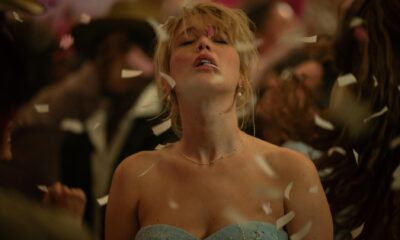

Features
Why Casino’s Nicky Santoro Is One Of The Most Terrifying Villains In Film History
Nicky Santoro stands as the embodiment of raw menace in Martin Scorsese’s 1995 film Casino. Joe Pesci gives him a fierce intensity that feels immediate and real, as though violence might erupt at any moment. His sudden shifts from cool talk to ruthless action create a constant sense of dread.
Through key moments of terror, like the desert showdown and the brutal pen-stabbing, Santoro reshapes the image of a mob enforcer on screen. His lasting influence lies in the way he blends charm of lucky player who play at non GamStop casinos, unpredictability and sheer force, leaving viewers unsettled long after the credits roll.
A Force Of Brutal Violence
Santoro’s cruelty shows in many key moments. He uses fear to stay in control. His violence comes without warning. Sam Rothstein, his friend and partner, feels the threat in every word and action.
Notable Acts Of Aggression
- He stabs a bar patron in the throat with a pen, gasping for air.
- He shouts threats so loud they echo in a phone booth.
- He barrels into a desert meeting, car skidding to a halt.
These acts do more than cause harm. They make him unpredictable. Even close allies fear what he might do next.
Explore the thrilling and sometimes terrifying world of casino villains, like Nicky Santoro, whose story has fascinated audiences for decades, and at the same time, new players can take advantage of exciting promotions such as https://norwaykryptocasino.com/100-kr-gratisbonuser/ to start their online casino journey with added value.
The Desert Confrontation Scene
The vast desert feels empty and full at once. Sam steps carefully, each footfall echoing over graves hidden by sand. His nerves show in every glance. Minutes later, Santoro’s car appears, tires throwing dust as it cuts into view.
Cinematic Tension
Scorsese frames the action through Sam’s sunglasses. The camera holds on the dark lenses and suddenly the speeding car blurs into focus. The music grows heavy—drums pound so loud they feel physical. When Santoro bursts from the car, the shot pulls back sharply, giving a moment of space before chaos.
Key techniques:
- Point of view: The choice to shoot through sunglasses puts us in Sam’s shoes.
- Sound design: Drums rise to a roar, signalling danger before we see it.
- Camera movement: A sudden pull-back heightens the shock of Santoro’s arrival.
Verbal Assault
The words feel like blows. Santoro clamps down on Sam from the first line. He paces close, voice low then rising like a whip. Sam tries to reason, but each reply is cut off.
Highlights:
- Rapid-fire insults: Santoro’s swearing lands like punches.
- Silencing tactic: He leans in until Sam cannot speak.
- Tight framing: Close shots shrink the space, turning open desert into a trap.
This mix of sight and sound makes the exchange feel trapped and violent.
Unpredictable Threat
Santoro’s real terror lies in the unknown. He swings between calm talk and sudden rage. His friend Sam never knows which will come.
- He can plan a meeting or spring an attack.
- He can praise Sam one moment, then strike next.
- He enjoys control and the shock of betrayal.
This unpredictability makes every scene uneasy. The threat hides behind a smile one moment and behind a fist the next.
The Real Life Inspiration
Joe Pesci drew on the story of Anthony “The Ant” Spilotro, a notorious mob enforcer in Las Vegas.
- Spilotro’s rise: He moved from Chicago to Vegas in the 1970s to oversee casino operations for the Chicago Outfit.
- Methods of control: He used threats, beatings and displays of force to keep crews in line.
- Pesci’s transformation: Before filming, Pesci studied photos, interviews and court documents to learn Spilotro’s posture and speech.
- On-set reaction: When Pesci first appeared in full costume and makeup, casino dealers froze or stepped back; some even fainted at the sight.
- Legacy of fear: Those reactions showed Pesci’s performance captured Spilotro’s cold menace so well that real people felt genuine danger.
Legacy And Influence
Santoro set a new standard for mob enforcers on screen. His mix of charm and violence shifted how villains appear in film. Other directors took note.
| Villain | Film | Key Trait | Year |
| Nicky Santoro | Casino | Unpredictable violence | 1995 |
| Tommy DeVito | Goodfellas | Chaotic charm | 1990 |
| Anton Chigurh | No Country | Silent menace | 2007 |
| Hans Landa | Inglourious | Calculated cruelty | 2009 |
This table shows how Santoro stands among great villains. His trait of violence at any moment set him apart.
Why He Endures
Nicky’s power comes from his human edge. He does not feel like a distant villain but someone who could exist next door. His anger springs from loyalty twisted by fear and pride. A single misstep against the mob code can set him off without warning.
Key reasons he still haunts viewers:
- Sudden outbursts: He shifts from calm talk to violent rage in an instant.
- Mob honour: He punishes anyone who steps out of line, even old friends.
- Quiet menace: A stare or soft word can feel more threatening than a shout.
Scorsese’s style lets that menace grow. He lingers on Pesci’s expressions and holds tight shots on his face. No bright colours or loud cuts distract from the threat. All attention remains on the raw force that Santoro brings to the screen.
Conclusion
Nicky Santoro changed how film villains feel. He shows that sheer rage and unpredictability can leave a deeper mark than any grand plot. His place as one of film’s most terrifying villains remains secure, as long as Scorsese’s Casino stands in cinemas.
FAQ
Who was the real-life model for Nicky Santoro?
Pesci based Santoro on Anthony “The Ant” Spilotro, a Chicago mob enforcer active in Las Vegas during the 1970s and 1980s.
What makes the desert confrontation so memorable?
The mix of tight camera work, pounding drums and a sudden car arrival builds shock and dread in an empty landscape.
How does Santoro stand out among other villains?
His blend of charm, sudden violence and loyalty twisted by fear creates an unpredictable threat unlike typical antagonists.
Why is unpredictability central to his terror?
It keeps both characters and viewers off-balance, never sure if a calm moment will turn into brutal action.
Which film techniques heighten his menace?
Scorsese locks on close-ups, uses point-of-view shots through sunglasses and layers sound design to amplify tension.
How did Santoro influence later villain portrayals?
He set a standard for enforcers with raw intensity and realism, inspiring filmmakers to craft more human yet frightening antagonists.
-

 Featured Review2 weeks ago
Featured Review2 weeks agoPredator: Badlands ★★★★
-

 Featured Review4 weeks ago
Featured Review4 weeks agoLondon Film Festival 2025 – Die My Love ★★★★
-

 Featured Review4 weeks ago
Featured Review4 weeks agoLondon Film Festival 2025 – 100 Nights Of Hero ★★★
-

 Featured Review3 weeks ago
Featured Review3 weeks agoBugonia ★★★★
-

 Movie Reviews3 weeks ago
Movie Reviews3 weeks agoShelby Oaks ★★★
-

 Interviews3 weeks ago
Interviews3 weeks agoInterview With Director/Actor James Sweeney (Twinless)
-

 Featured Review4 weeks ago
Featured Review4 weeks agoLondon Film Festival 2025 – Anemone ★★★★★
-

 Featured Review3 weeks ago
Featured Review3 weeks agoLondon Film Festival 2025 – Dreamers ★★★★

